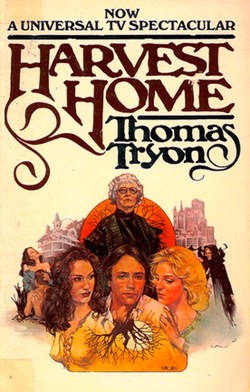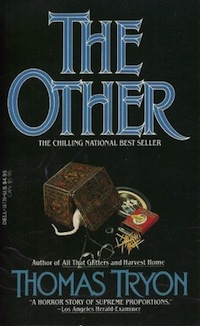Summer of Sleaze is 2014’s turbo-charged trash safari where Will Errickson of Too Much Horror Fiction and Grady Hendrix of The Great Stephen King Reread plunge into the bowels of vintage paperback horror fiction, unearthing treasures and trauma in equal measure.
Three books launched the horror revival in America: Rosemary’s Baby (1967), The Exorcist (1971), and The Other (1971). Thanks to their blockbuster movies, we all remember Rosemary’s Baby and The Exorcist, but these days you’d be hard pressed to find someone who’d read Thomas Tryon’s The Other. The first two are still in print, while Tryon’s book, which sold 3.5 million copies, is only in print from the New York Review of Books which specializes in forgotten and obscure literature.
Even stranger, Tryon’s next book, Harvest Home, came out in 1973 and became another huge hit, although these days it’s only available as an ebook. Fully a third of our horror roots are missing, which is too bad because while The Other isn’t as good as Rosemary’s Baby it’s a far, far better-written book than The Exorcist.
Tryon was an actor who had, as People magazine put it, “a relentlessly mediocre acting career in Hollywood.” He spent most of his time looking square-jawed and all-American in television Westerns, was passed over for the Sam Loomis role in Hitchcock’s Psycho, starred as the titular monster in I Married a Monster From Outer Space, played soldiers and sailors and astronauts in a bunch of forgettable flicks, and finally played the lead role in Otto Preminger’s The Cardinal for which he received a Golden Globe nomination and, according to Tryon, a nervous breakdown thanks to his mistreatment at the hands of the dictatorial director.
Vowing that he would henceforth always be in a position to fire the director, Tryon tried to become a producer, but his treatment for a movie about evil twins called The Other wasn’t getting any traction so he borrowed money from his family, locked himself away for 18 months and turned it into a novel. The Other was instantly heralded as a classic and Tryon hit the road, doing interviews and selling his book practically door to door. His reward was massive sales and critics falling all over themselves to proclaim it a masterpiece.
Probably nobody thought it was a masterpiece more than Tryon himself. This is a book that is trying very, very hard to prove that it is a capital “b” Book, written in a style that would be called “Creative Writing Workshop Standard” these days, full of epic-poetic descriptions of nature, elliptical dialogue, a focus on sensory description, and naturalistic scenes that sprawl and meander without seeming to arrive at any particular point. But Tryon had a secret weapon, the notorious page 196 referred to breathlessly by many reviewers.
Like The Exorcist and Rosemary’s Baby, Tryon’s book is about an evil child, in this case Holland Perry, a literal evil twin living on a remote farm in the summery New England countryside that is coated in sunlight and honey, a rural paradise right out of Ray Bradbury. His twin, Niles, is the good boy, constantly apologizing for Perry’s pranks that turn darker, and darker, and then become murderous. Page 196 contains the novel’s “you must read this” twist, which has been worn smooth to modern eyes by a million M. Night Shyamalans and doesn’t quite carry the punch it used to, and that’s not entirely bad. Without the twist to blow our minds, modern readers can submerge themselves in the prose and, despite being self-consciously literary, it’s worth the submersion.
?Tryon comes across as a nice guy, but he doesn’t play nice with his readers. Although The Other starts slow, wallowing in bucolic country living, Tryon has some mean treats stored up his sleeve. Once you get used to his writing style and can no longer hear the bellows and wheezes of his efforts to prove he is A Great Writer with his “dark sullen days” and “mouths open in a silent scream” and afternoons “spread lavishly, like a picnic on a cloth of light and shade” you find yourself lulled into a state of semi-hypnosis, completely unprepared for a series of very nasty set pieces that climaxes with one of the worst parties ever put down on paper. Tyron underplays his shocks, which makes all the dead babies floating in jars, severed fingers, and pitchforks hidden in the hay loft hurt your eyeballs that much harder.
Tryon wrote the screenplay for the inevitable movie version, but he hated the finished result. Directed by Robert Mulligan (To Kill a Mockingbird) the movie never became a hit and Tryon blamed everyone. “Oh, no. That broke my heart. Jesus. That was very sad,” he says of the finished film. “That picture was ruined in the cutting and the casting…God knows, it was badly cut and faultily directed. Perhaps the whole thing was the rotten screenplay, I don’t know.” But, like Stephen King talking about The Shining, Tryon protests too much and misses the fact that this adaptation of his book is a classic in its own right. One of the first rural gothics, bathed in golden sunlight, it’s a surreal and menacing forerunner to later movies like The Reflecting Skin, a bastard love child of America’s two great Normans: Rockwell and Bates.
 Aggressively literary, understated, and ultimately depressing, The Other is a prime candidate for literary obscurity, but it’s harder to understand why Tryon’s next book still isn’t in print today. Harvest Home was his only other horror novel, and it’s a doozy. Released in 1973, it sold a few million copies, but never became a movie, instead becoming a television miniseries called The Dark Secret of Harvest Home starring Bette Davis. Set in a sleepy Connecticut village, Harvest Home kicks off with artist Ned, his wife, and their daughter ditching dirty old New York City for the rural paradise of Cornwall Coombe—which appears to be the town that time forgot. In a trope that readers will by now be all-too-familiar with, it turns out that the town takes its corn harvest a little too seriously. By the time Ned realizes that all these local yokels are actually very dangerous people, he’s gotten himself in way too deep; the annual celebration of the corn, Harvest Home, turns out to be the kind of party to which you don’t really want to be invited.
Aggressively literary, understated, and ultimately depressing, The Other is a prime candidate for literary obscurity, but it’s harder to understand why Tryon’s next book still isn’t in print today. Harvest Home was his only other horror novel, and it’s a doozy. Released in 1973, it sold a few million copies, but never became a movie, instead becoming a television miniseries called The Dark Secret of Harvest Home starring Bette Davis. Set in a sleepy Connecticut village, Harvest Home kicks off with artist Ned, his wife, and their daughter ditching dirty old New York City for the rural paradise of Cornwall Coombe—which appears to be the town that time forgot. In a trope that readers will by now be all-too-familiar with, it turns out that the town takes its corn harvest a little too seriously. By the time Ned realizes that all these local yokels are actually very dangerous people, he’s gotten himself in way too deep; the annual celebration of the corn, Harvest Home, turns out to be the kind of party to which you don’t really want to be invited.
Today, this kind of rural horror, where pagan fertility rituals crash into city slickers with their framed country quilts and adorable folk art museums, seems pretty common, but in the early ’70s it was not. Rural folk horror erupted suddenly in the late ’60s and was strongest in England where bands like Comus and movies like Blood On Satan’s Claw (1971), The Wicker Man (1973) and television movies like Robin Redbreast (1970) and Penda’s Fen (1974) as well as the BBC’s televised adaptations of M.R. James ghosts stories were using the British countryside to deliver a new kind of fear. Full of standing stones, fertility rituals, maypoles, Horned Gods, and the wind whipping through trees, the past was coming back to haunt modern day England. Once upon a time, villagers feared a bad crop, or a charm placed on them by some fellow villager. This new fear being excavated up out of the loam was a fear of the people who still clung to these beliefs in the modern world and, even worse, a deeper, unspoken fear that these quaint abandoned rituals and declawed traditions might still have a power our plastic world of superhighways and microwave ovens lacked.
Tryon’s Harvest Home is a great big galumph of a book that’s in no hurry to get anywhere. Clocking in at over 400 pages, it’s the kind of leisurely read that reflects its setting, Cornwall Coombe, where nothing ever seems to happen faster than a horse-drawn cart, and where life is slow, gentle, quiet, and “real.” Fortunately, Tryon is a much more confident writer this time around and while there’s plenty of gasping and breast-clutching over nature’s beauty, it feels less jarring in a book that’s all about nature’s beauty being a dangerous deception. It takes a while, but by the time nature starts to show its teeth, Cornwall Coombe is such a quaint idyllic paradise that you’re in as deep a denial as the characters. Surely it can’t be as bad as all that? Let’s all just take a breath and be reasonable. Please?
The only flaw with Harvest Home is that it’s definitely a novel from another time, and some of the traps that Tryon sets for his audience will be wasted on modern readers who might not have the patience to walk through this labyrinth at his pace. Ned is a character who is improbably handsome and he struts around Cornwall Coombe like King Stud while women throw themselves at his feet, panting and sweaty. It all seems a bit improbable, and Tryon is fully aware of it. Ned’s vanity (and he is vain, no matter how many times he claims otherwise) is a trap that takes 300 pages to spring, and I can imagine some readers who want “likeable characters” throwing the book across the room well before they reach that point.
But we read plenty of other dated books, so it’s a mystery as to why Harvest Home has been so forgotten, because this is one of American horror’s most important novels. Despite all the folk horror crawling out of the rich English dirt, Harvest Home and The Other were the only two major American representatives of that trend, and they tilled this earth well before Stephen King revisited it with “Children of the Corn.” Tryon mined the same surreal soil as Ray Bradbury did in his books like Something Wicked This Way Comes, wringing a particularly American brand of horror out of autumn leaves and corn husks and country fairs, and once you read these two books you’ll see Thomas Tryon in the DNA of almost everything Stephen King wrote before The Stand. All three writers—King, Bradbury, and Tryon, and, going back further, Lovecraft—looked at the same New England landscape and saw the same traces of something ancient, something bloody, and something dangerous lurking just beneath the thin crust of civilization smeared across the surface of that unforgiving ground.
Grady Hendrix is the author of Satan Loves You, Occupy Space, and he’s the co-author of Dirt Candy: A Cookbook, the first graphic novel cookbook. He’s written for publications ranging from Playboy to World Literature Today and his story, “Mofongo Knows” appears in the anthology, The Mad Scientist’s Guide to World Domination.










